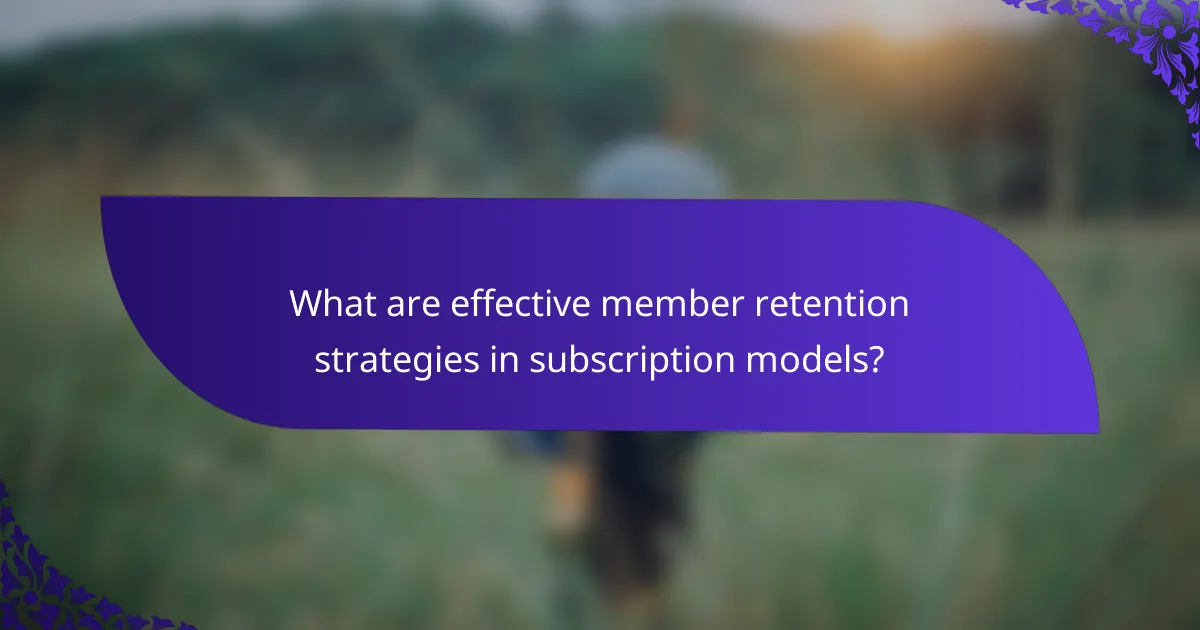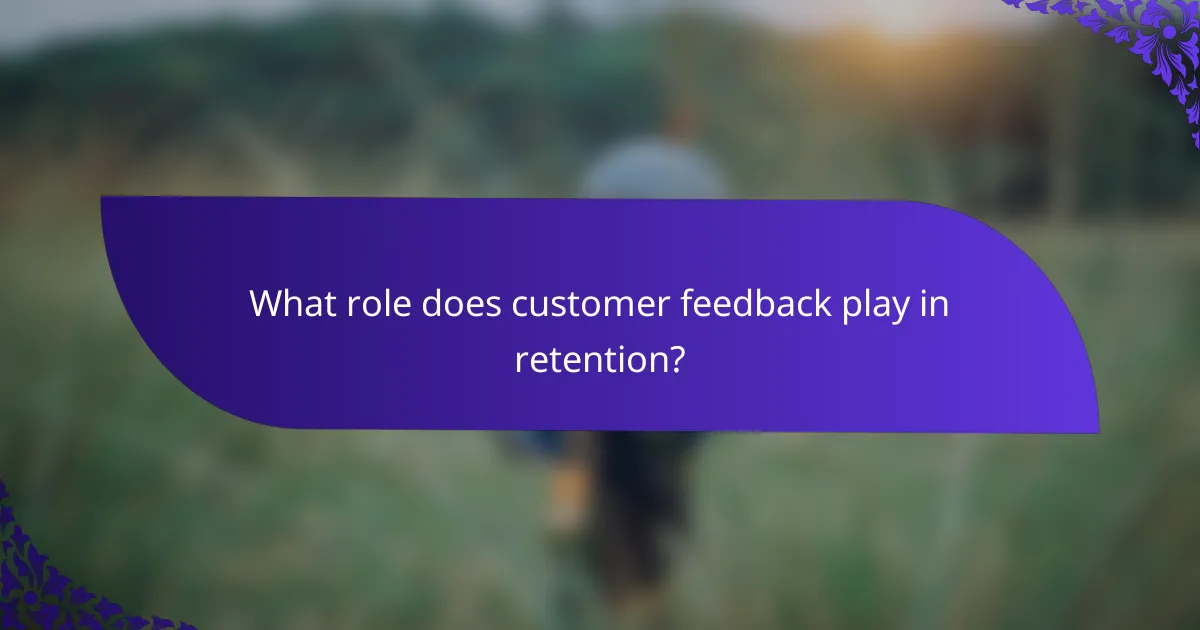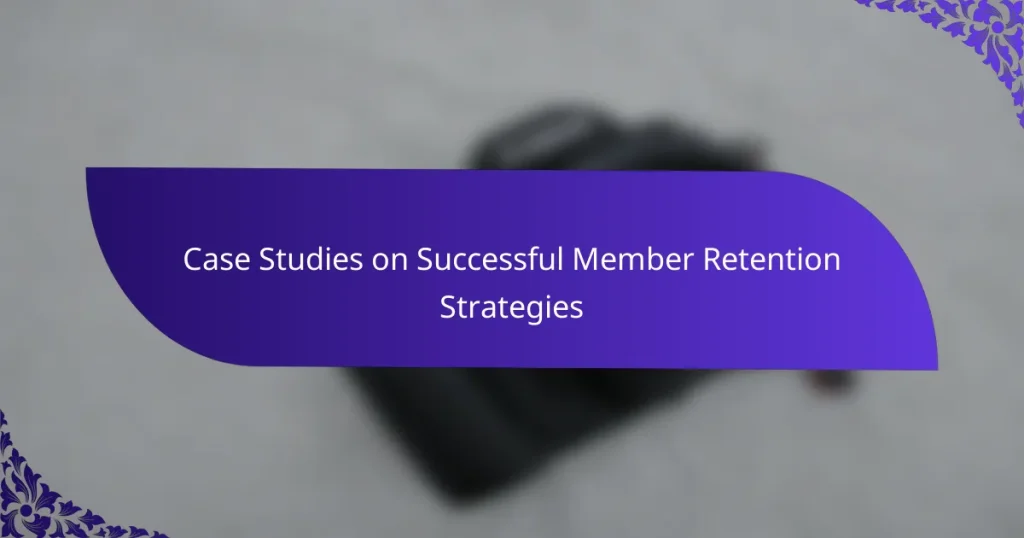In today’s competitive landscape, effective member retention strategies are crucial for subscription-based businesses aiming to enhance customer satisfaction and loyalty. By focusing on personalized experiences, valuable benefits, and community engagement, organizations can foster strong connections with their members, encouraging long-term loyalty. This introduction explores successful case studies that highlight these strategies and the key metrics used to measure their effectiveness.

What are effective member retention strategies in subscription models?
Effective member retention strategies in subscription models focus on enhancing customer satisfaction and loyalty through targeted initiatives. These strategies aim to create a personalized experience, foster community, and provide ongoing value to members.
Personalized communication
Personalized communication involves tailoring messages and interactions to meet the specific needs and preferences of each member. This can include using their name, referencing their past interactions, or suggesting content based on their interests.
To implement this, businesses can utilize data analytics to segment their audience and craft targeted email campaigns. Regular check-ins and personalized offers can significantly enhance the member experience and reduce churn.
Loyalty programs
Loyalty programs reward members for their continued patronage, encouraging them to stay engaged. These programs can include points systems, tiered rewards, or exclusive discounts that incentivize members to renew their subscriptions.
For example, a subscription box service might offer points for every purchase that can be redeemed for free products or discounts. Implementing a well-structured loyalty program can lead to increased member retention and higher lifetime value.
Community engagement
Community engagement fosters a sense of belonging among members, which can significantly enhance retention. Creating forums, social media groups, or hosting events encourages members to connect and share experiences.
For instance, a fitness subscription service might create an online community where members can share workout tips and progress. This not only builds loyalty but also encourages members to remain active participants in the service.
Feedback loops
Establishing feedback loops allows members to share their thoughts and experiences, which can be invaluable for improving services. Regular surveys, suggestion boxes, or direct outreach can help gather insights on member satisfaction and areas for improvement.
Acting on feedback demonstrates to members that their opinions matter, which can strengthen their commitment to the subscription. Regularly updating members on how their feedback has been implemented can further enhance trust and loyalty.
Exclusive content access
Offering exclusive content access is a powerful retention strategy that provides members with unique value. This can include premium articles, videos, webinars, or early access to new products that are not available to non-members.
For example, a streaming service might offer exclusive behind-the-scenes content or early releases to its subscribers. Ensuring that the exclusive content is high-quality and relevant can significantly boost member satisfaction and retention rates.

How do successful companies implement retention strategies?
Successful companies implement retention strategies by focusing on personalized experiences, valuable member benefits, and fostering community engagement. These approaches create strong connections with customers, encouraging them to remain loyal over time.
Netflix’s content personalization
Netflix utilizes sophisticated algorithms to analyze viewer preferences and behavior, allowing it to deliver personalized content recommendations. This tailored experience keeps users engaged and increases the likelihood of continued subscriptions.
By constantly updating its library and leveraging user data, Netflix ensures that subscribers find relevant content that matches their tastes. This strategy has proven effective in reducing churn rates, as members feel their viewing experience is uniquely catered to them.
Amazon Prime’s member benefits
Amazon Prime enhances member retention through a variety of benefits, including free shipping, exclusive deals, and access to streaming services. These perks create a compelling value proposition that encourages users to maintain their memberships.
Additionally, Amazon frequently introduces new features, such as Prime Video and Prime Music, which further enrich the member experience. This continuous expansion of benefits keeps members engaged and less likely to cancel their subscriptions.
Peloton’s community building
Peloton fosters a strong sense of community among its users through interactive features like live classes, leaderboards, and social sharing options. This community engagement not only enhances the workout experience but also builds loyalty among members.
By encouraging users to connect with each other and share their fitness journeys, Peloton creates a supportive environment that motivates members to stay committed. This sense of belonging is a key factor in retaining customers long-term.

What metrics measure member retention success?
Key metrics for measuring member retention success include churn rate, net promoter score (NPS), and customer lifetime value (CLV). These metrics provide insights into how well an organization retains its members and the overall satisfaction and value derived from those relationships.
Churn rate analysis
Churn rate analysis involves calculating the percentage of members who leave over a specific period. A high churn rate can indicate dissatisfaction or better offerings from competitors, while a low rate suggests effective retention strategies. Typically, organizations aim for a churn rate in the low single digits.
To calculate churn rate, divide the number of members lost during a period by the total number of members at the start of that period, then multiply by 100. Regularly monitoring this metric helps identify trends and areas needing improvement.
Net promoter score (NPS)
The net promoter score (NPS) gauges member loyalty by asking how likely they are to recommend the organization to others. Responses are scored on a scale from 0 to 10, with scores of 9-10 indicating promoters and 0-6 indicating detractors. A higher NPS suggests stronger retention potential.
To calculate NPS, subtract the percentage of detractors from the percentage of promoters. Organizations should aim for an NPS above 50 to indicate strong member satisfaction and loyalty.
Customer lifetime value (CLV)
Customer lifetime value (CLV) estimates the total revenue a member will generate during their relationship with the organization. Understanding CLV helps prioritize retention efforts by focusing on high-value members. A common benchmark is to aim for a CLV that is at least three times higher than the cost of acquiring a new member.
To calculate CLV, multiply the average purchase value by the average purchase frequency and the average member lifespan. This metric allows organizations to tailor their retention strategies based on the value of different member segments.

What are common challenges in member retention?
Member retention faces several common challenges that organizations must navigate to maintain a loyal base. Key issues include market competition, member disengagement, and value perception, each of which can significantly impact a member’s decision to stay or leave.
Market competition
Market competition refers to the presence of alternative options available to members, which can lead to higher attrition rates. Organizations must continuously assess their competitors’ offerings and adapt their own services to remain appealing. This might include improving pricing strategies, enhancing service quality, or introducing innovative features.
To effectively combat competition, consider conducting regular market analyses to identify trends and shifts in member preferences. Engaging with members through surveys can also provide insights into what they value most compared to competitors.
Member disengagement
Member disengagement occurs when individuals feel less connected or invested in an organization, often leading to increased cancellations. This can stem from a lack of communication, inadequate support, or failure to meet expectations. Regular engagement through newsletters, events, and personalized outreach can help maintain interest and connection.
To prevent disengagement, organizations should implement feedback mechanisms to understand member concerns and preferences. Establishing a community through forums or social media can also foster a sense of belonging and encourage active participation.
Value perception
Value perception is how members view the benefits they receive relative to the costs they incur. If members feel they are not receiving adequate value, they are more likely to leave. Organizations need to clearly communicate the benefits and advantages of membership, ensuring that members understand what they gain.
To enhance value perception, regularly highlight success stories, testimonials, and tangible benefits that members have experienced. Offering tiered membership levels can also cater to different needs and budgets, making it easier for members to see the value in staying engaged.

How can technology enhance member retention?
Technology can significantly enhance member retention by streamlining communication, personalizing experiences, and providing valuable insights into member behavior. By leveraging various tools, organizations can create a more engaging and responsive environment that meets the needs of their members.
CRM systems
Customer Relationship Management (CRM) systems are essential for managing member interactions and data throughout the member lifecycle. These systems help organizations track member preferences, engagement levels, and feedback, allowing for tailored communication and services.
When selecting a CRM, consider features like automation, integration with other tools, and user-friendliness. Popular options include Salesforce, HubSpot, and Zoho, which offer various pricing plans to fit different budgets.
Data analytics tools
Data analytics tools enable organizations to analyze member data and identify trends that can inform retention strategies. By understanding member behavior and preferences, organizations can implement targeted initiatives to improve satisfaction and loyalty.
Common tools include Google Analytics for web engagement and Tableau for data visualization. Regularly reviewing analytics reports can help organizations adjust their strategies based on real-time insights, ensuring they remain relevant to their members’ needs.
Automated communication platforms
Automated communication platforms streamline outreach efforts by sending personalized messages to members at key moments. These platforms can help maintain engagement through welcome emails, reminders, and follow-ups based on member activity.
Tools like Mailchimp and Constant Contact offer automation features that allow organizations to set up workflows based on member actions. This not only saves time but also ensures that members receive timely and relevant information, enhancing their overall experience.

What role does customer feedback play in retention?
Customer feedback is essential for retention as it provides insights into member satisfaction and areas needing improvement. By actively seeking and responding to feedback, organizations can enhance their offerings and strengthen member loyalty.
Understanding customer needs
Understanding customer needs through feedback allows organizations to tailor their services effectively. Regular surveys, interviews, and feedback forms can reveal what members value most and what they find lacking. This information helps in prioritizing enhancements that directly impact retention.
Implementing changes based on feedback
Implementing changes based on customer feedback demonstrates that an organization values its members’ opinions. For instance, if members express dissatisfaction with a specific feature, addressing that concern can lead to increased satisfaction and loyalty. Organizations should track feedback trends and prioritize actionable insights for improvement.
Communicating changes to members
Communicating changes made in response to feedback is crucial for retention. Members need to see that their input leads to tangible results. Regular updates via newsletters or social media can keep members informed and engaged, reinforcing their connection to the organization.
Measuring the impact of feedback
Measuring the impact of feedback on retention rates helps organizations assess the effectiveness of their strategies. Tracking metrics such as member satisfaction scores and churn rates before and after implementing changes can provide valuable insights. This data can guide future decisions and enhance overall retention efforts.


